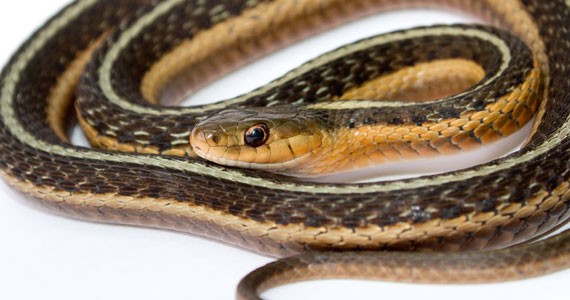What you've heard about Georges Island is true: It's crawling with garter snakes. There are between 400 and 500 garters, based on the latest survey. And although that's a lot for such a small space, they seem to have found plenty of places to hide. The chance of seeing one of these slithery denizens is small, since they hide out in dark dingy places like under old beams of wood, or in the long grass.
"They are very well-hidden," says Carla Wheaton, with Parks Canada. "Many people have gone over and have never seen them, it's not a common sight."
The Hey Rosetta! show will see over 2,500 people visit the concert site on Georges Island. The glacial drumlin---and its snakes---haven't seen this much activity in centuries, so it will likely be at least a small shock to their system.
"It's my understanding that the noise is not a concern," Wheaton says. "We've consulted experts about how we can mitigate the impact on the snakes and they've provided us with some recommendations that we can follow to limit the impact."
One recommendation is to only mow the grass in areas where the stage, staff and concertgoers will be, leaving lots of long grass for the garter snakes to listen to the music in peace. The site will be mowed as early as possible, which should keep the snakes away from the area until the concert is over.
The snake population has handled human activity in the past---since the founding of Halifax in 1749 there has been an almost continuous human presence on the National Historic Site until the late 20th century. And so far nobody has emulated the Whacking Day holiday as seen on The Simpsons.
But who cares, they're just garter snakes, right? Well, it turns out they've evolved since arriving on the island (anywhere from several thousand to a few hundred years ago). Darwin's famous example of changes in reptiles holds true here.
"They are different in terms of certain traits, although they aren't different enough from their mainland counterparts to be considered a new species," Wheaton says. "They have more scale abnormalities in terms of how the scales form, and some are also melanistic, they're basically black. It's a small percentage, maybe three percent of the snakes are melanistic, and the rest are a variety of colours---brown, green, orange, their scales vary significantly."
The Georges Island snakes are also smaller than their mainland cousins, perhaps because there are fewer food options on the island. So enjoy the show, and an opportunity to check out Georges Island up close---but please, watch your step.
Colin Chisholm is a freelance reporter who endured a garter snake bite as a child.













